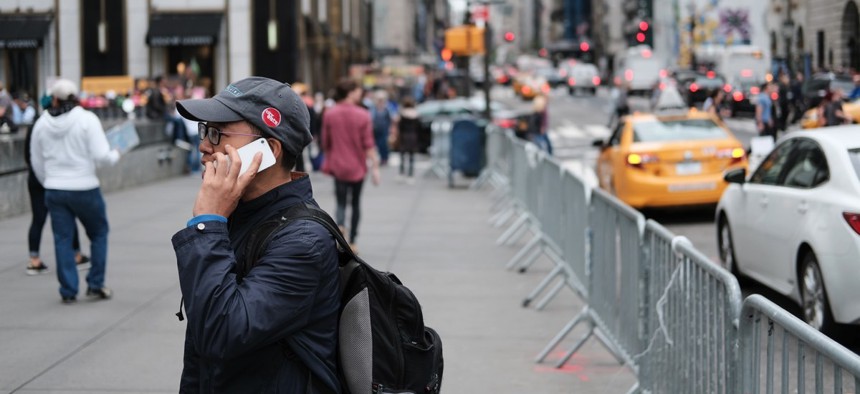Will the Supreme Court Take Up Cellphone Surveillance?


Connecting state and local government leaders
The U.S. Supreme Court could soon consider whether police can review a cellphone’s whereabouts without a warrant.
Statistically speaking, you’re most likely reading this story on a cellphone somewhere in the United States. If you are, you’re using one of more than 378 million cellphone accounts in the country. The data forming these words is beaming to your phone by way of between 300,000 and 600,000 cell towers—a vast telecommunications archipelago that spans from Seattle to Orlando, binding Americans and their devices to one another in a tangled digital web.
Traversing that web leaves tracks. By tracing the cell towers an individual device interacts with, law-enforcement agencies can track where you’ve been, how long you were there, and when you left. What’s more, the police can obtain all of that data without a warrant. But that could change if the U.S. Supreme Court agrees to take up two major Fourth Amendment cases, Graham v. United States and Carpenter v. United States, for its upcoming term in October.
The defendants in both cases reached the Court by separate but similar paths. Two separate federal juries convicted Aaron Graham, Timothy Carpenter, and Timothy Sanders on multiple counts of armed robbery. In Graham’s case, the targets were gas stations and fast-food restaurants in Baltimore in 2010 and 2011; Carpenter, Sanders, and their accomplices chose multiple electronic stores in Michigan and Ohio in 2011.
After their arrests, federal investigators asked judges for access to what’s called “historical cell-tower location information,” or historical CSLI. The application wasn’t a warrant, which would have required investigators to show probable cause. Instead, they used what’s called a 2703(d) order, named after the provision of the federal Stored Communications Act that establishes it, to apply for the records.
After reviewing them, investigators in both cases determined that the suspects’ cellphones had interacted with cell towers near the sites of each robbery when the robberies occurred. Carpenter and Sanders were sentenced to 1,395 months—more than 116 years—in prison, while Graham received a 1,764-month sentence. The Fourth and Sixth Circuit Courts of Appeal upheld their respective convictions and the use of the historical CSLI data at trial, after which the defendants asked the Supreme Court for review.
At issue in both cases is the burden of proof police must meet before a judge can grant access to historical CSLI. The 2703(d) orders require a lower standard: Investigators must provide “specific and articulable facts showing that there are reasonable grounds to believe that the records or other information sought are relevant and material to an ongoing criminal investigation.” That’s considered to be a more relaxed threshold than what’s needed to obtain a typical warrant under the Fourth Amendment.
The burden-of-proof gap between 2703(d) orders and warrants springs from the third-party doctrine, a legal principle first articulated by the Supreme Court 40 years ago. Under the doctrine, Americans have no “reasonable expectation of privacy,” a key Fourth Amendment test, when voluntarily disclosing information to a third party like a phone company and or a bank. That gives police broad latitude to obtain a suspect’s information without a warrant when it’s held by a company or similar entity.
That leeway has drawn criticism from academics and civil-liberties advocates. Elizabeth Joh, a University of California, Davis, law professor, said the doctrine is one of two major Fourth Amendment issues that “really calls out for reconsideration.” (The other, she said, is the border-search exception, which lowers Fourth Amendment protections at or near ports of entry.) Both of the main Supreme Court decisions upon which the third-party doctrine is built date back to the 1970s, when telecommunications technology was far less advanced.
“The real issue is: Does it make sense to keep applying these pre-digital-era cases to a totally different context?” Joh asked.
At least one member of the Supreme Court has indicated a willingness to reevaluate the doctrine’s modern utility. In the 2012 case United States v. Jones, the justices unanimously ruled that attaching a GPS device to a suspect’s car and tracking them without a warrant violates the Fourth Amendment. Some justices, like the late Antonin Scalia, argued it constituted a trespass; others argued it violated a person’s reasonable expectations of privacy. But Justice Sonia Sotomayor went further and suggested revisiting the third-party doctrine in its entirety.
“More fundamentally, it may be necessary to reconsider the premise that an individual has no reasonable expectation of privacy in information voluntarily disclosed to third parties,” she wrote in a concurring opinion. “This approach is ill-suited to the digital age, in which people reveal a great deal of information about themselves to third parties in the course of carrying out mundane tasks.” She cited as examples the common disclosure of URLs and emails to internet providers and cellphone numbers to phone companies.
Sotomayor isn’t the only justice whose views would be closely watched if the Court were to consider the cases. Scalia tended to favor the defendant in Fourth Amendment cases more often than his colleagues on the Court’s conservative wing. But it’s unclear if his successor, Neil Gorsuch, will follow that same path. Jennifer Lynch, a senior staff attorney with the Electronic Frontier Foundation, an organization that’s filed amicus briefs in the cases, pointed to a Tenth Circuit decision of Gorsuch’s last August in which he sided with the defendant. In U.S. v. Ackerman, the future justice applied Scalia’s reasoning in Jones to non-physical intrusions like digital searches.
It’s “unclear” whether he would do the same in a CSLI case, Lynch told me, but the increasing sophistication of cellphone technology means the Court will likely need to address the issue soon.
“Something like 90 or more percent of Americans now have cellphones, and we all carry them around with us, and you don’t have control over the location information that’s collected by your cellphone provider,” she said. “So I think the Court is going to need to think about things like these advances in technology, and how the Fourth Amendment keeps pace with that.”
Matt Ford is an associate editor at The Atlantic, where this article was originally published.

NEXT STORY: Machine learning enlisted for Defense applications





